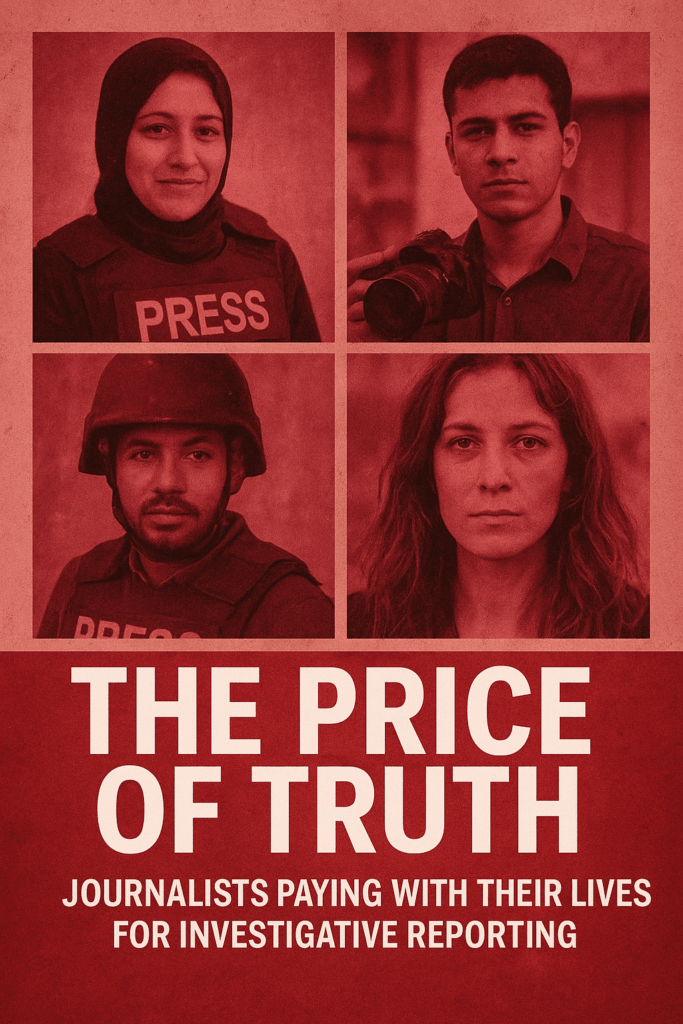Investigative journalists across the globe continue to face lethal danger, operating under threats of violence, war, and political suppression. As conflicts deepen and suppression intensifies, the profession’s risk has never been more stark. The cost of speaking truth is being counted in bodies as well as stories.
Deaths in 2024 Marked a Grim Record
A report from the Committee to Protect Journalists (CPJ) revealed that 124 journalists were killed in 2024, making it the deadliest year on record for those in the profession. Nearly 70 percent of those deaths were attributed to Israel, largely connected to the Israel-Hamas war. Countries such as Sudan, Pakistan, Mexico, Haiti, Myanmar and Mozambique were also among those with high fatalities among media workers.
Recent Tragedies and High-Profile Case Studies
-
On August 25, 2025, an airstrike on Nasser Hospital in Gaza struck twice first in upper floors, then targeting rescuers and journalists rushing to the scene. At least 20 people died, including five journalists. Among them was Mariam Dagga, 33, a visual journalist with the Associated Press
-
Another attack in Sana’a, Yemen, on September 10 destroyed a newspaper complex, killing 31 journalists and media workers. A child accompanying a journalist was also among the dead. The Committee to Protect Journalists called it one of the deadliest attacks on the press in recent history.
-
In addition, Yahya Sobeih, a journalist and editor in Gaza City, was killed in July 2025, alongside family members in an Israeli airstrike on a displacement tent. His death, among others, emphasizes the blurred lines in conflict zones between civilian safety and journalistic exposure.
Why This Is Happening
Several factors contribute to these dangerous trends:
-
Conflict Zones Without Safe Zones: Hospitals, media buildings, and even tents are increasingly struck in zones considered protected under international law. Investigative reporting in such areas requires not just courage, but willful exposure.
-
Weaponization of Disinformation: Governments and armed groups frequently allege that journalists are affiliated with opposition or militant groups. Sometimes such claims justify violent reprisals.
-
Lack of Accountability: Investigations into these deaths are often slow, partial, or never conclude. Perpetrators are rarely brought to justice. This impunity emboldens further attacks.
-
Targeting of Local Reporters: Many victims are local journalists without international protection, working in communities where oversight or safe extraction is difficult.
Demands from Journalists and Rights Groups
Human rights and press freedom organizations have issued several strong demands:
-
Full and transparent investigations of attacks on media workers.
-
Better protection measures in conflict zones: safe corridors, early warning, recognition of media as civilians.
-
International pressure on states and armed groups who violate protections under international humanitarian law.
-
Recognition of journalists especially local and freelance ones as frontline defenders of accountability and truth.
What This Means for African and Global Journalism
For African journalists, this wave of violence threatens to degrade investigative journalism, reduce accountability, and weaken democratic oversight. When those who uncover corruption, abuses or war crimes are silenced, entire societies pay the price. Truth becomes dangerous. Silence becomes the safer path.
Yet many journalists persist. Their work pushes back against impunity, giving voice to the voiceless. As the risks rise, so do calls for stronger global mechanisms to guard their lives and their stories.


